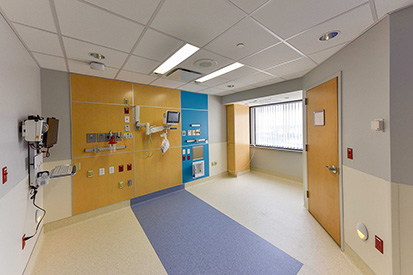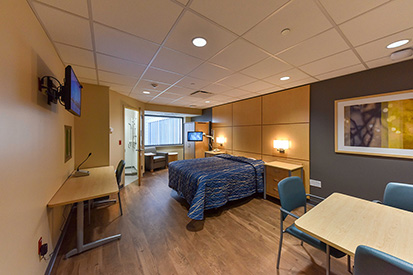The suite enables delivery of an investigational drug for aggressive neuroblastomas
ST. LOUIS, MO – Siteman Kids at St. Louis Children’s Hospital is opening a new, lead-lined therapy suite to treat children with rare, high-risk neuroblastomas – an aggressive cancer of the nerve cells that spreads quickly and typically affects children younger than 5. Made possible by significant philanthropic support from multiple donors to St. Louis Children’s Hospital, the lead-lined therapy suite is one of only 20 dedicated to children in the country and the only one of its kind in Missouri and within 300 miles of St. Louis.
 This 275-square-foot hospital room is designed specifically to treat children with high-risk neuroblastomas using an investigational drug – a radiopharmaceutical that delivers targeted radiation directly to tumor cells. The suite includes a lead-lined patient room and an adjacent, hotel-like, private room so family members can stay close while being protected from radiation exposure. There is also an entry area where doctors and nurses can safely prepare to enter the patient room to care for the child.
This 275-square-foot hospital room is designed specifically to treat children with high-risk neuroblastomas using an investigational drug – a radiopharmaceutical that delivers targeted radiation directly to tumor cells. The suite includes a lead-lined patient room and an adjacent, hotel-like, private room so family members can stay close while being protected from radiation exposure. There is also an entry area where doctors and nurses can safely prepare to enter the patient room to care for the child.
With the therapy suite, Washington University physicians will participate in several clinical trials evaluating the effectiveness of meta-iodobenzylguanidine (MIBG) treatment in children with aggressive neuroblastoma. The treatment combines radioactive iodine (I-131) with MIBG, a compound easily absorbed by neuroblastoma cells. It is given to a child through an intravenous, or IV, line.
A patient is admitted to the hospital 24 hours before therapy begins so he or she can get used to the room, and for the nurses to get to know the child and family. Once the treatment is given, MIBG goes to neuroblastoma tumors and delivers its radiation. Children receiving the therapy need to stay in the special lead-lined room during treatment and for about three days afterward, until most of the radiation has left their body. The I-131 MIBG therapy is recommended for patients ages 12 months or older.
“This new suite will make a big difference in the lives of our young patients and their families,” said Frederick Huang, MD, a Washington University pediatric hematologist/oncologist at Siteman Kids at St. Louis Children’s Hospital. “In the past, families in our region would have to travel several hundred miles for this advanced treatment. A lot of effort has been put into the design of the suite to keep patients and parents as close together as possible, and the children will be cared for by a team of doctors and nurses with broad expertise in treating neuroblastomas.”
The standard treatment options for neuroblastoma include surgery to remove the tumor, external radiation therapy, chemotherapy, bone marrow transplant and immunotherapy.
 The lead-lined suite is designed so staff can care for the patient safely and parents can stay nearby their child during and after treatment. The patient room and adjacent private room for families includes a lead-lined window so everyone can see each other. Both rooms include a bathroom with a shower, two-way audio and visual communication and televisions. Patients can also bring their favorite toys from home as long as they can be easily wiped down and decontaminated.
The lead-lined suite is designed so staff can care for the patient safely and parents can stay nearby their child during and after treatment. The patient room and adjacent private room for families includes a lead-lined window so everyone can see each other. Both rooms include a bathroom with a shower, two-way audio and visual communication and televisions. Patients can also bring their favorite toys from home as long as they can be easily wiped down and decontaminated.
“We’re excited to offer MIBG therapy here at St. Louis Children’s Hospital,” Huang said. “This advanced therapy adds to the repertoire of treatments we’re able to offer to children in the region.”
Cancer care can be stressful for the entire family, so St. Louis Children’s Hospital provides additional support prior to and during a child’s hospitalization, which includes meeting with a child life specialist and social workers.
According to the American Cancer Society, neuroblastoma affects about 800 U.S. children each year and is the most common cancer in infants younger than 12 months. St. Louis Children’s Hospital-Washington University School of Medicine were recently ranked No. 24 in the country for pediatric cancer care by U.S. News & World Report.
For more information about the suite, MIBG therapy and Siteman Kids at St. Louis Children’s Hospital, visit StLouisChildrens.org, or call 314.454.6000.
# # #
For 140 years, St. Louis Children's Hospital has provided exceptional care for children in all 50 states and 80 countries around the world. With its academic partner, Washington University School of Medicine, Children’s is consistently ranked among the nation’s best pediatric hospitals by U.S. News & World Report. A member of BJC HealthCare, St. Louis Children’s Hospital follows one simple mission – to do what’s right for kids. That mission comes to life through medical discovery, innovative therapies and compassionate care. In 2018, Children's expanded with a state-of-the-art, 12-story medical tower. Children’s relies on generous donations to deliver specialized care for families in need, extend health care services to the community, and pursue research that promises to transform pediatric medicine. To find out more, visit StLouisChildrens.org, Facebook, Twitter and Instagram.
Siteman Cancer Center, ranked among the top cancer treatment centers by U.S. News & World Report, also is one of only a few cancer centers to receive the highest rating of the National Cancer Institute (NCI) – “exceptional.” Comprising the cancer research, prevention and treatment programs of Barnes-Jewish Hospital and Washington University School of Medicine in St. Louis, Siteman treats adults at six locations and partners with St. Louis Children’s Hospital in the treatment of pediatric patients, through Siteman Cancer Network, Siteman Cancer Center works with regional medical centers to improve the health and well-being of people and communities by expanding access to cancer prevention and control strategies, clinical studies and genomic and genetic testing, all aimed at reducing the burden of cancer.
Washington University School of Medicine’s 1,500 faculty physicians also are the medical staff of Barnes-Jewish and St. Louis Children’s hospitals. The School of Medicine is a leader in medical research, teaching and patient care, ranking among the top 10 medical schools in the nation by U.S. News & World Report. Through its affiliations with Barnes-Jewish and St. Louis Children’s hospitals, the School of Medicine is linked to BJC HealthCare.

